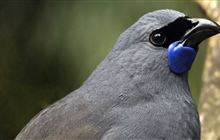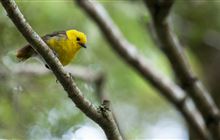Predator control in the Dart, Caples and Routeburn Valleys
Archived content: This media release was accurate on the date of publication.
Introduction
More predator control is needed to protect a nationally-important mohua/yellowhead population from local extinction.Date: 16 July 2019
A critically endangered mohua/yellowhead population at the head of Lake Wakatipu could face local extinction due to an expected plague of predators.
Department of Conservation operations manager Geoff Owen says a network of more than 1,000 traps in the Caples, Dart and Routeburn valleys has been holding the line for the small but nationally-important mohua population, but with predator numbers exploding due to the huge amount of seed fall this year, more intensive protection is needed.
"This year our beech forests have produced extremely heavy seeding, known as a mega mast, and produced vast amounts of seed - up to 15,000 seeds per square metre. This provides a bounty of food for native insects and birds but also for rodents, whose populations can expand rapidly. When the seed runs out, they turn to our vulnerable species."
"In response to the mega mast DOC is planning an aerial 1080 operation this winter to control rat numbers in the Dart, Caples and Routeburn valleys as part of DOC’s national Tiakina ngā Manu (formerly Battle for our Birds) programme."
A second operation in the summer months may also be required if rodent numbers rebound quickly due to the massive amount of food available to them.
While the focus for this year’s Wakatipu operation is to protect mohua, other species such as pekapeka/southern long-tailed bat, whio/blue duck, New Zealand robin/toutouwai and kākā will also benefit from the reduction in pests, Geoff Owen says.
"We want to do all we can to protect these taonga. If rat numbers climb as expected, they will overwhelm our network of over 1,000 traps in the valleys. Aerially-applied 1080 is the most effective way of knocking down predators to enable a successful breeding season for our birds."
The pest control operation over about 19,000ha will commence during the first period of good weather after 1 August and will occur over two separate days. On the first day, non-toxic pre-feed pellets will be laid to accustom pests to the pellets as food. About a week later (weather depending) the toxic bait pellets will be sown.
All walking tracks within the control area will be closed during the pre-feed and toxic bait operations for up to one day each time, and deer repellent will be used with the 1080 cereal bait to minimise the risk to deer across all three valleys, Geoff says.
"This is a special area close to many locals’ hearts," Geoff adds.
"Anyone who has visited these valleys recently will have seen and heard the beautiful birdsong, brought about by sustained predator control. But it only takes one heavy mast year to lose these gains. If we do nothing we are facing local extinction we need to do all we can to prevent this."
Background information
Landowners, businesses, community services and recreation groups potentially affected by the pest control operation will be contacted by the DOC Queenstown office.
Mohua were once one of the most abundant and visible birds in the New Zealand forest but numbers have dwindled to just 5,000 nationwide.
The population in the Dart/Routeburn/Caples area is particularly vulnerable due to its small size. It is also one of four nationally recognised stronghold for mohua; in the other three locations the mohua populations are better established – the need for us to safeguard these nationally vulnerable birds is critical and we cannot afford to do nothing.
A second operation in late summer may be required, and the decision around this will be made based on the outcome of ongoing rat monitoring.
This year is a mega mast year, which means the food for predators is significantly more abundant than in previous years. Without predator control, this is expected to lead to very high rodent and stoat numbers from spring 2019.
Aerially applied 1080 is the only effective tool we have to control rats when their numbers increase significantly following a beech mast event. On average we get a 95% reduction in rat abundance when we use it. Without it we would have lost mohua in the Dart/Caples valleys years ago.
Contact
For media enquiries contact:
Email: media@doc.govt.nz


